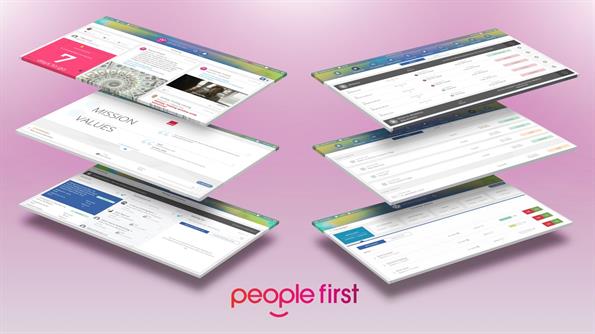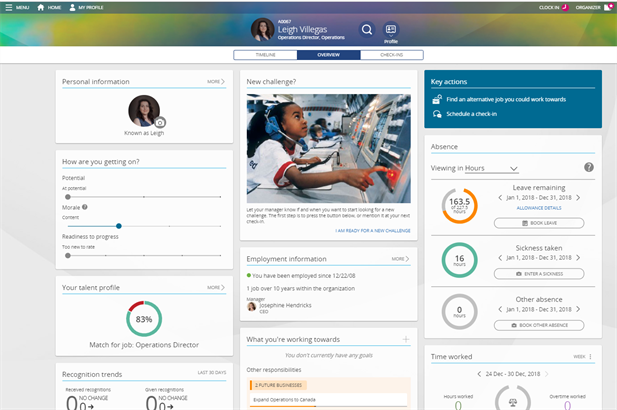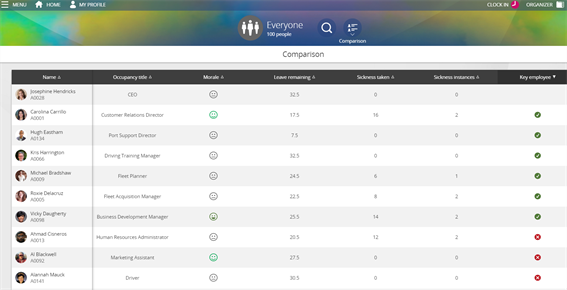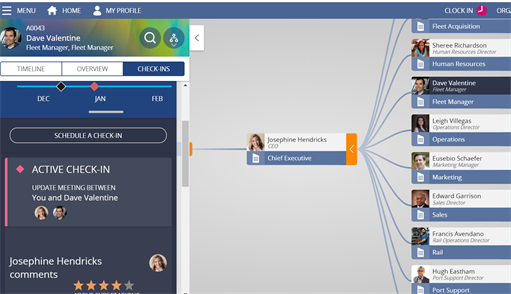People First Human Resources System
Understanding the future of work
Global, Flexible, Secure, and Scalable
Personal Digital Assistants
People Analytics and Employee Profiles
Check-Ins opposed to Yearly Performance Reviews
Personnel Time Off (PTO)
Learning Management
Calendar Integrations with Outlook and Google
Payroll Integrations
Recruitment and Application Tracking
Talent Management and Resource Planning
Organizational and Employee Goals
Secure with ISO & SOC II Accreditation, GDPR Compliant
12 Hour Implementations to include Data Loads

People are a company’s most valuable asset. The best companies to work for are those who place a clear value on human capital. These companies are often the most profitable, regardless of the economic climate. Great businesses stay attuned to the worth of their intellectual assets and are aware of the impact a creative, engaged, and cohesive workforce will have on producing outstanding customer relations. The innovation, growth, and competency, for which such a company is known for, ultimately ensures customer happiness. Even in our digital age, people will continue to be a vital core of any business, small or large. For a company to continue their success, their priority should be to seek, examine, and integrate ways of assessing its human capital, while continuing to cultivate their existing workforce for tomorrow’s needs.
Employee Engagement Drives Success
Multiple times throughout our work day, we as individuals experience moments where we choose to either put in more effort or less effort than what is required or expected of us. Engaged workers will often strive to add more effort (and subsequently add better value) to their daily work. For these employees, their job is not just a paycheck, but a career with the potential for advancement and the fulfilment they feel in the connections they make with their employer and fellow cohorts.
They uplift their coworkers when they feel a strong team bond. They innovate when they know they have a voice that can be heard by management and others. They energize the business and make it a fun and attractive place to work for other potential (and sought-after) new hires.

By contrast, a Disengaged employee will passively or actively undermine the good done by engaged personnel, thus causing demoralization to spread throughout the company. Good hiring processes will help to minimize this culture of disengagement. Having a great onboarding system, with easy-to-use software, makes for a consistent onboarding process that increases engagement on the job from Day 1.
Great pay and benefits matter just as much as consciously hiring people who are not only talented, but who will engage with other staffers to make your company a community. If you have any disengaged employees, you can still help them to reengage with your workforce.Behind every disengaged employee is a potential worker with a store of untapped human capital. Measuring and cultivating engagement is the most effective way to improve business performance, success in audits, and profitability.
New Habits for Encouraging Employee Engagement
Ask employees for their opinions. Act on their answers. Employees will often know your staff, products, processes, and clientele better than any C-Level Executive. Trust in them to give you the information you need to optimize it all. Reward their ideas when they work and give them public credit to motivate your other staffers. Methodically choose managers with the talent of inspiring others who bring more x-factor to your company. Make employee engagement a key pillar in your business culture. Managers must ensure staffers are respected as individuals, with their own personalities and managers should work to uncover and document the unique hidden talents each employee brings.
Your most creative personnel will avoid jobs that stifle their creativity and force them to feel like insignificant cogs in a machine. Create a workplace that helps to fulfil a person’s life (on and off the job).By cultivating an inclusive environment where people know they made the right choice for employment, you then establish a strong company workforce that can whether any storm without everyone jumping ship after each bump in the road on the way to becoming an industry leader.

High Employee Turnover Dampens Engagement and Morale
Some turnover is healthy and to be expected when running your business. However, valuable skills and tribal-knowledge will walk out the door as ex-employees leave the building. An unhealthy pattern of turnover will take a toll on a company’s reputation and its bottom line.This is especially true with online sites (such as glassdoor) where your potential candidates will read about your work environment (usually from the unhappiest employees) when deciding where to work.This will also affect how much they ask for, especially if your company appears toxic or unpleasant as compared to a company where the application pool will probably be very high.
Retaining people and being known for retention is vital given the surge in online hiring sites and the ease with which current and former staffers may review their employers. If your company’s current employee turnover percentage exceeds the national average of 3.7%, then the need to lower this is especially urgent. There are no shortcuts. It takes a consistent and concerted effort to retain employees and ensure your turnover rate always stays below the national average. Software can help with establishing targets and goals and ensure accountability mechanisms are in place to help aid in meeting your goals while ensuring none of your employees and their feedback slip through any cracks.
Reduce Employee Turnover by Understanding Expectations and Recognizing Greatness
The average length of time an employee stays with a company is four years, and this trend is shrinking year by year. Why should businesses inspire their employees to stay longer? Because it may take up to two years for an employee to know their job inside and out and perform it at an optimal pace. The best way to retain employees is to learn and acknowledge their expectations. Take surveys at regular intervals to help gauge the satisfaction of your workforce. A good employer acknowledges that outside of work their employees have lives, hardships, and dreams. Good business policies will support the quality of those lives, help to ease hardships, and give pathways of hope to one day achieving their dreams.
Establish metrics for measuring and rating personal growth and encourage improvement day by day. A bad work environment were employees are subjected to a constant barrage of criticism, are in constant fear of losing their job, and/or are pitted against each other and expected to rise to the challenge and overcome the manufactured stress of poor mismanagement is ineffective. Management should have a steady, reliable style, and earn the staff’s trust and respect.
We Focus on Regular Check-Ins, as Opposed to Yearly Evaluations
Managers should recognize great work. Staffers appreciate regular recognition. It boosts retention, rewards productivity, enhances safety, and keeps people engaged. Engagement is lost over the course of a year – even a quarter. The best way to maintain consistent and active engagement is via the use of periodic “check-ins”.
Check-Ins may be done weekly or monthly. They are not meant to replace an annual performance review, but instead supplement it with the information and achievements that many of us forget or remember differently over the course of a year. These are quick 1 to 5-minute touch points a manager should have with all of their employees throughout the week or month. When the end-of-year review times comes, your managers and their staff aren’t spending hours, days, even weeks combing through a year’s worth of emails, procrastinating because it’s just too much, or racking their brains thinking of good things to say and constructive criticism to give based on what is most recent or fresh in their memory.

You’d need an employee to work 2 years before establishing a baseline and trajectory using only annual reviews and a 3rd year to see if they changed course. With our Check-Ins integrated into your HR system, you can establish a baseline in the first week, monitor their progress throughout the year, and help guide each employee the instance their performance begins to dive or plateau. It is this constant feedback loop that drives engagement and incentivizes staff to improve each week. Those staffers who are used to years of slipping through the cracks and doing the bare minimum are sussed out immediately and given goals to pursue and a touch point conversation with management to help them find better fulfillment in their work.
Talent Management Means Consciously Noticing Peoples’ Potential for Growth
Talent management is a strategy. Through talent management companies retain talented people by offering real avenues for continued professional development. HR plays a core role in performance management and employees’ career planning. HR can supply funding for training and support for talent management, but the point person here is a person’s direct manager. The manager is the one approves professional development and who knows their staff’s personal perspective on any given day. Good managers can serve their staff as a career coach or guide them towards someone who can better answer career related questions.
Managers have the awesome responsibility of recognizing outstanding work and the ensuring their employee’s continuing job satisfaction – on top of their non-managerial tasks they must also perform. This can prove daunting, especially in a lean workforce where everyone is wearing multiple hats. The “management” side of the manager title will often come last in priority to their other tasks, thus reducing this great responsibility to the bare minimum of approving time and complaining about writing annual reviews.
Our software implementation aims to curtail this trend of the “accidental manager” or “manager by default” by not only giving them the tools to manage and engage with their staffers on a career and work-satisfaction level, but to also give your company the tools to manage-the-managers and ensure they are all performing their managerial duties and enforcing company policies when it comes to managing and engaging their staff.
Explore more about the latest management systems that are helping businesses excel in tending to their human capital. Staying informed about your talent management and helping it to grow over time means drawing in and retaining the best employees and protecting your company’s greatest asset.
Burcamp provides the People First HCM solution to help address these concerns and improve employee engagement.

